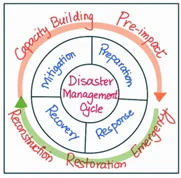Answer:
| Approach:
Introduction
- Start your answer with Vulnerability and risk assessment play a pivotal Role in pre-disaster management.
Body
- Significance of vulnerability and risk assessment in pre-disaster management.
Conclusion
- Summary of the answer with futuristic approach.
|
Introduction:
Vulnerability and risk assessment play a pivotal role in pre-disaster management, providing crucial insights into the potential impacts of disasters. By evaluating the vulnerabilities of communities, infrastructures, and ecosystems, and assessing the associated risks, administrators can effectively allocate resources and develop targeted strategies.

Body:
Significance of vulnerability and risk assessment in pre-disaster management
- Enhancing Preparedness: Vulnerability and risk assessment inform administrators, aiding preparedness. Identifying high-risk areas and populations aids customized planning, resource allocation, early warning systems, evacuation routes, and emergency response training.
- Resource Allocation: Vulnerability and risk assessment optimize resource allocation. It enables administrators to allocate resources efficiently based on prevalent vulnerabilities and risks in different regions, ensuring targeted support for vulnerable areas and deployment of resources according to risk severity.
- Community Engagement: Effective vulnerability and risk assessment entails community engagement. Administrators should collaborate with local stakeholders, including community leaders, NGOs, and grassroots organizations. This fosters ownership, raises awareness, and empowers individuals to participate in disaster management, enhancing overall resilience.
- Early Warning Systems: Vulnerability and risk assessment guide the creation of efficient early warning systems. Administrators utilize this knowledge to design prompt alert mechanisms that effectively reach at-risk communities. Such systems aid in timely evacuations, vital information dissemination, and coordinated emergency responses, thereby minimizing damage and saving lives.
- Infrastructure and Lifeline Systems: Vulnerability and risk assessment aid administrators in identifying and fortifying critical infrastructure. By evaluating vulnerabilities in transportation, communication, power, and water supply networks, administrators prioritize enhancements and implement resilience measures.
Conclusion
Vulnerability and risk assessment form the foundation of a robust disaster management system. As an administrator, key areas to focus on include conducting comprehensive vulnerability and risk assessments, fostering interagency collaboration, implementing early warning systems, strengthening infrastructure resilience, ensuring community engagement, and prioritizing capacity-building initiatives.
